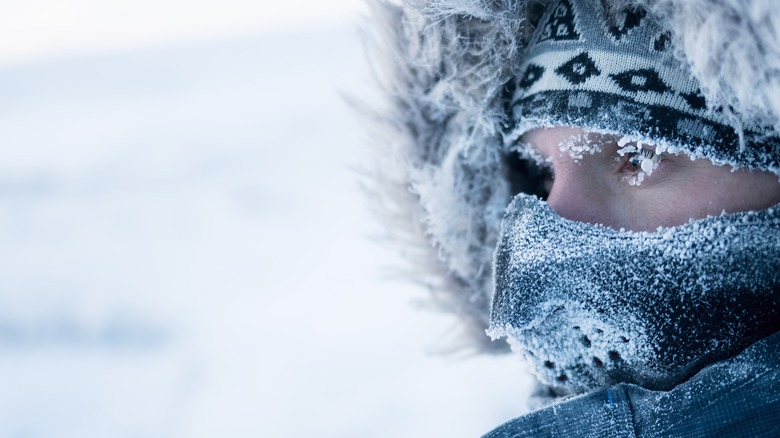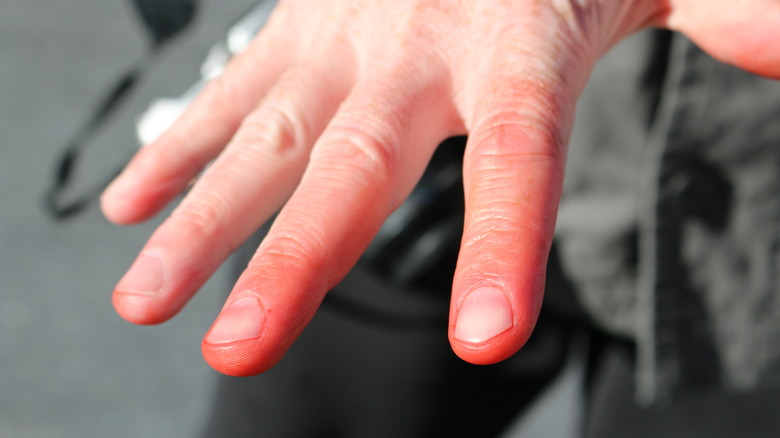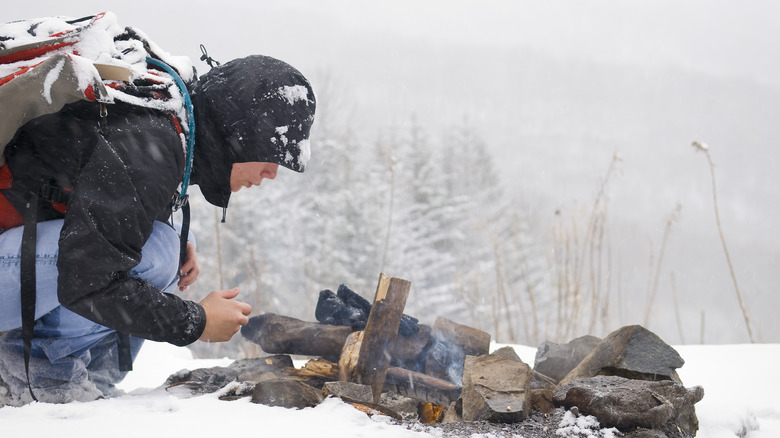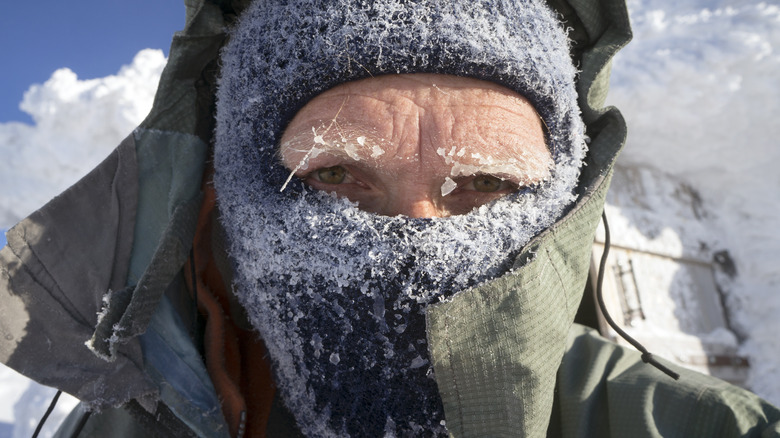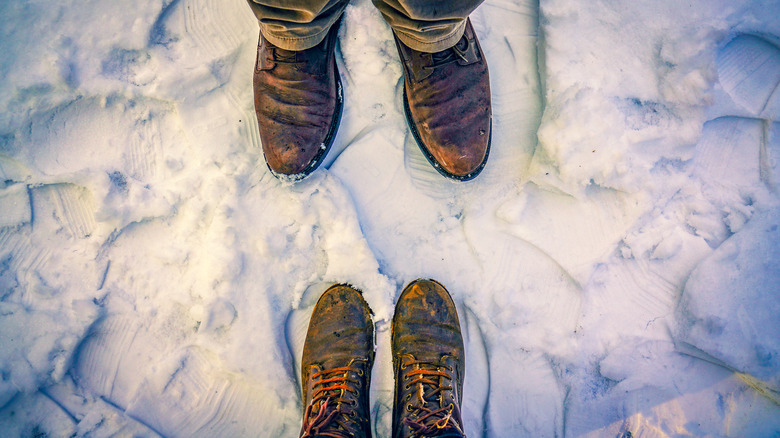How To Treat Frostbite In The Wilderness
Frostbite is an injury that you can get from prolonged exposure to freezing temperatures. The earliest stage may only require self-administered first aid, while the later stages require the help of a medical professional and can cause lasting damage. The best thing for frostbite at any level is to get back indoors — but what about when that isn't possible? What if you are in the wilderness, miles from civilization, without a doctor?
Treating frostbite in the wild is difficult. It can be difficult to even tell how severe frostbite damage to the skin and underlying tissue really is while you're still out in the cold, because the tissue freezes, leaving the area pale, hard, and numb, regardless of how much damage has actually been done. As described by the Wilderness Medical Society Practice Guidelines for the Prevention and Treatment of Frostbite published by Wilderness and Environmental Medicine, with the exception of special situations in which a person is at greater risk of frostbite due to a medical condition or medication, it is easier to prevent frostbite than to treat it. If you're going to go out into the wilderness at a time when it will be below freezing, you should make sure to dress warmly, stay hydrated, and keep moving. If it's already too late, here's how you can try to mitigate the effects of frostbite in the wilderness.
Immediately after frostbite is detected
If your fingertips, toes, nose, or ears are feeling numb and you can't easily get feeling back into them, it's time to start worrying about frostbite. If you can get back to civilization, where you can be in a warm place and receive medical care, you should.
If you can't, you should try to get inside out of the cold immediately. If you can't get to a warm place quickly, at least prioritize finding a dry area that is protected from wind and rain. If your clothes are wet or sweaty, you should change into dry clothes immediately. Anything on the frostbitten body part that might be constrictive like jewelry, tight clothes, or shoes, should be removed.
In an interview with Explorers Web, Dr. Monica Piris, an expedition doctor for mountaineers in the Himalayas, stated that if you have access to O2 canisters, you should use them. If you have the ability to make a warm, sweet drink, you should have one. The single most important thing you have to do, however, is to make a plan for how you're going to get to safety.
Determine if you will be able to keep it warm
The best thing to do if you potentially have frostbite is to get to a warm place and stay there, but sometimes that isn't possible. Even though letting frostbite continue is very dangerous, in some situations, it may actually be better not to thaw out your frozen body right away.
Ideally, frostbitten areas are warmed in warm water, around 100°F or 38°C, under the supervision of a doctor who can manage the pain you're experiencing. In the wild, this probably won't be possible. If it's possible to keep your frostbitten body part warm afterward, you should probably attempt to thaw it — but if it's likely that the injured area will quickly freeze again as you make your way back to civilization, thawing it on your own may do more harm than good. Repeatedly refreezing the same tissue can cause even more damage. Once the area is warmed, you will have to keep it thawed, manage the pain, and stay extremely hydrated all while still in the wilderness. Still, it is a bad idea to intentionally keep a frostbitten area frozen — if it will thaw naturally as you evacuate, you should definitely let it.
Rapidly rewarming it on your own
The US Army protocol states that if there will be more than 2 hours of wait time for medical treatment, soldiers should try field rewarming or thawing out the affected part without medical assistance. If you believe that you can keep the affected area warm after, you should try thawing out the frostbitten body part on your own. As tempting as it may be, you should avoid just holding it over a fire, however. The best method would be to heat water to around 100°F or 38°C, but this can be hard to determine without a thermometer. As an alternative, you can test the water with an undamaged hand or arm to ensure that it is not too hot. The body part with frostbite will likely have lost too much sensation to tell. For best results, the water should be kept at the same temperature and swirled around the injured body part regularly until the skin becomes red or purple and is no longer unnaturally hard. This may take around half an hour.
If you have access to some basic medicines, you can use them to help. Adding an antiseptic to the water for rewarming might help prevent any infections, so if you have it, you might as well use it. Rewarming can be an extremely painful process, so if you have pain medications like NSAIDs that you know you can tolerate safely, you may want to take them before attempting to rewarm your body.
Walking on frozen toes
In a perfect world, you wouldn't use frostbitten hands and feet to climb out of a mountain crevasse or hike along the tundra — but if that's your way back to safety it may be necessary. Usually, wrapping up a still-frozen, frostbitten body part isn't recommended, but in situations where you may have to use those body parts to escape your current situation, it may be the best option. If using the body part cannot be avoided, you should pad it, splint it, and immobilize it as much as possible to prevent causing any more damage. Any dressings that you choose to apply should be loose to accommodate swelling. If available, a dry gauze dressing is the best option.
In addition to being more fragile, the area will likely be numb, so it may be more difficult to tell if you are doing damage to your frostbitten areas than usual. Monitoring it and making sure that the padding is working may help to keep the injury safe while you make your way to safety.
Apply aloe vera and elevate
Getting to a safe, warm place is the most important thing you can do if you have frostbite in the wilderness. If you can't do that right away, you might want to try a few things to keep the symptoms from getting worse while you wait for rescue or evacuation.
If you don't have to keep moving to escape a dangerous situation, you may want to try elevating the frostbitten hands and/or feet up over the level of your heart. This will help to prevent swelling and edema, and unless you need to use that body part for survival, it's harmless, so it is definitely worth trying.
If you happen to have brought a topical aloe vera cream or gel with you, you may want to try applying it to any frostbitten areas. Some research has shown that, if your frostbite is still only skin-deep and hasn't penetrated the tissue, it may be able to help. It likely won't help more severe cases, but there is very little risk to trying it out. If possible, apply after thawing the injured area and then cover with a loose, dry gauze dressing.
